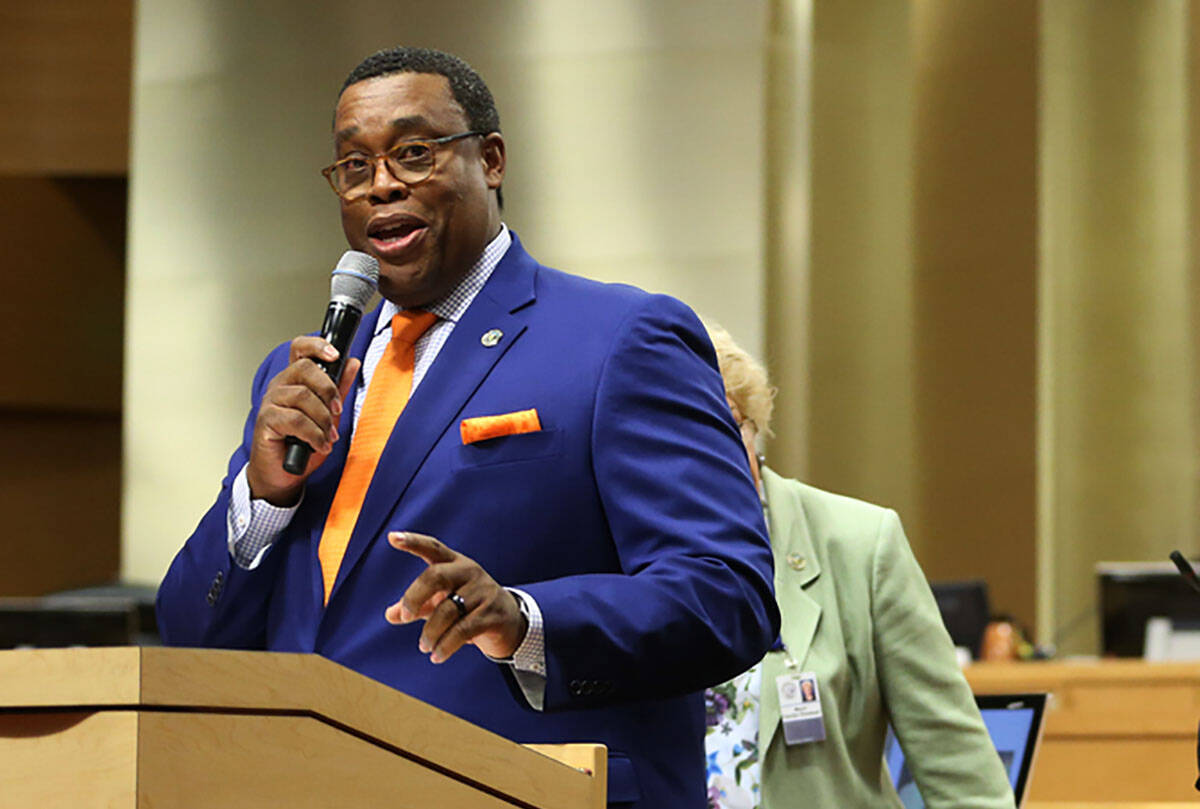Las Vegas councilman helps put Historic Westside back on the map
Las Vegas councilman helps put Historic Westside back on the map
December 3, 2021
By Shea Johnson Las Vegas Review-Journal
During a roundtable discussion in early November, Las Vegas Councilman Cedric Crear introduced himself to federal, state and city leaders inside the Historic Westside School.
Sen. Catherine Cortez Masto, D-Nev., and Assistant Secretary of Commerce Alejandra Y. Castillo were among the several officials seated in the room, along with Clark County Commissioner William McCurdy II and Crear, who both represent the area.
“I literally can almost shed a tear,” Crear said, acknowledging the presence of the high-ranking officials who had come to the underdeveloped neighborhood just north of downtown Las Vegas.
In Crear’s eyes, the fact that the west Las Vegas school played host to the event further demonstrated that the Historic Westside was back on the map.
“It sends a message,” he said after the talks had ended.
The attention is welcome as the neighborhood undergoes a forward-looking city strategy for revitalization, one which had received considerable community input before its first phase launched in July 2020.
The HUNDRED Plan In Action got underway in the throes of a pandemic but, during an interview in September from his City Hall office, Crear recalled telling city officials that he refused to allow the development blueprint to be set aside by the public health crisis.
“We are not going to allow this to be another reason why we don’t execute on this plan,” he said.
Crear’s fears appear thus far to have been avoided as projects move forward with a big lift from private and non-city government funds, including dollars made available because of the COVID-19 pandemic.
“In essence, I think it’s probably given us an opportunity to have a bigger platform than we might have had,” Crear said, referencing the public health crisis.
Federal, state funding help
Officials arrived to the Nov. 10 roundtable to discuss, in part, increased broadband connectivity that would be coming to the Historic Westside as a result of the bipartisan $1 trillion infrastructure package that had passed days earlier.
They also addressed a $6.9 million coronavirus relief grant awarded in February through the U.S. Department of Commerce’s Economic Development Administration. It will help to fund a 10,000-square-foot job training facility just north of the school.
The state allotted $4 million to assist with the operation and construction of the facility, the Westside Workforce Education and Training Center, which is a collaboration with the College of Southern Nevada. It is expected to increase access to high-demand jobs in health care, advanced manufacturing and other sectors after its construction sometime in 2023.
The first phase, the Strong Future Technology Center, is already open and training students in science, technology, engineering and math. Cox Communications funded the equipment to create the innovation lab inside the center, Crear said.
Private support also a boon
A community farming facility and co-op grocery store planned at James Gay Park is expected to open next year. It is backed by a program grant sponsored by the U.S. Environmental Protection Agency and the Department of Agriculture’s Agricultural Marketing Service. MGM Resorts International is contributing $500,000 to its development.
There have also been talks about a health and wellness center in partnership with UNLV and Roseman University, according to Crear. As late as September, officials were eyeing a parcel on the corner of H Street and Jackson Avenue for the project.
Crear said the health center would provide preventative care, noting how the pandemic reinforced health disparities faced in communities of color such as the Historic Westside, which is predominantly Black and Hispanic.
Two nearly 15-foot-tall sculptures titled “Queen of the Arts,” christened by local dignitaries in April, were installed at the West Las Vegas Arts Center. The Howard Hughes Corp. gave $40,000 to the city’s nonprofit to complete and install the pieces.
Then in October, the city unveiled two refurbished outdoor basketball courts at the Doolittle Community Center, supported by a $200,000 donation to the city’s nonprofit from the The Shaquille O’Neal Foundation and Icy Hot.
“It’s very rewarding to me on a personal level, as I have lived in Las Vegas and know firsthand the tough times that these areas have gone through in the past,” O’Neal said in a statement.
Money to remain key issue
On Saturday, Crear and other dignitaries celebrated the opening of the Historic Westside Legacy Park in partnership with Clark County. It is unclear whether the park, a $3.2 million tribute to prominent figures in the westside, received any outside investment.
Most of the vision of the HUNDRED Plan In Action has yet to be tied to funding. And Crear has acknowledged that the long-term effort is without an end date and bound to be inherited by his successor on the city council.
“I don’t have a set timeline but I will say that the landscape of the Historic Westside in five to 10 years will look completely different than it does today, and I think it’ll be moving in a much more positive direction,” he said.
The city is considering more moves for the area, including a mixed-income housing project with retail on the bottom floor; an art and culture museum; and potentially a new library.
Change promised, but time will tell
Crear said new restaurants have opened up in the broader Ward 5 district that encompasses the Historic Westside and that the neighborhood has even played host to eSports tournaments.
“Not only are we doing brick and mortar, I think we’re changing the environment of the community as well,” he said. “And that’s important. People feel as though things are happening, that we are not being overlooked anymore.”
According to Crear, there are “tens and tens of millions of dollars” being invested into the Historic Westside, which he sees as a major shift from actions and attitudes of the past.
“It’s a stark contrast to where we were,” he said.

